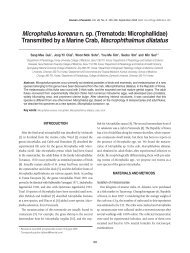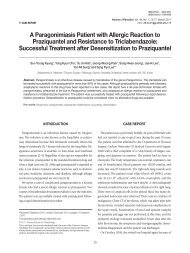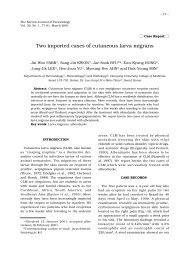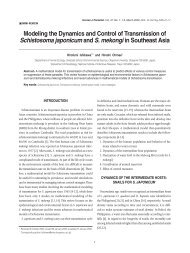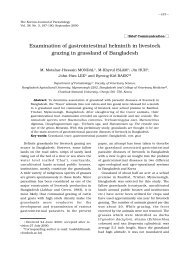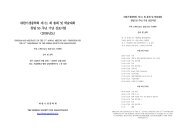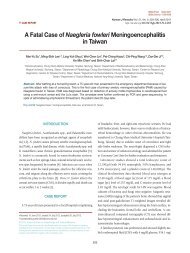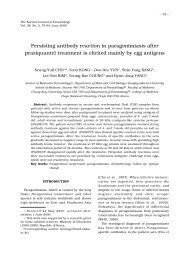A case of Strongyloides stercoralis infection - KoreaMed Synapse
A case of Strongyloides stercoralis infection - KoreaMed Synapse
A case of Strongyloides stercoralis infection - KoreaMed Synapse
You also want an ePaper? Increase the reach of your titles
YUMPU automatically turns print PDFs into web optimized ePapers that Google loves.
─117─<br />
The Korean Journal <strong>of</strong> Parasitology<br />
Vol. 37, No. 2, 117-120, June 1999<br />
A <strong>case</strong> <strong>of</strong> <strong>Strongyloides</strong> <strong>stercoralis</strong> <strong>infection</strong><br />
Case Report <br />
Sung-Jong HONG 1) * and Joo-Hee HAN 2)<br />
Department <strong>of</strong> Parasitology 1) , Chung-Ang University Faculty <strong>of</strong> Medicine, Seoul 156-756,<br />
and Chung-Ang Clinic 2) , Ahneuy-up, Hamyang-gun, Kyongsangnam-do 676-820, Korea<br />
Abstract: Strongyloidiasis has been recognized as one <strong>of</strong> the life-threatening parasitic<br />
<strong>infection</strong>s in the immunocompromised patients. We report an intestinal <strong>infection</strong> <strong>case</strong> <strong>of</strong><br />
<strong>Strongyloides</strong> <strong>stercoralis</strong> in a 61-year-old man. Rhabditiform larvae were detected in the<br />
stool examination and developed to filariform larvae having a notched tail through the<br />
Harada-Mori filter paper culture. The patient received five courses <strong>of</strong> albendazole therapy<br />
but not cured <strong>of</strong> strongyloidiasis.<br />
Key words: <strong>Strongyloides</strong> <strong>stercoralis</strong>, human <strong>infection</strong>, albendazole, filariform larva<br />
The intestinal nematode, <strong>Strongyloides</strong><br />
<strong>stercoralis</strong>, is a soil-transmitted nematode<br />
endemic in many countries throughout<br />
tropical and temperate regions, and is<br />
responsible for a wide range <strong>of</strong> symptoms<br />
(Grove, 1989). In warm climates, the parasite<br />
lives the free-living generation in humid soils.<br />
When the microenvironment changed to<br />
unfavorable circumstances (dry and/or cold<br />
temperature), rhabditiform larvae transform to<br />
filariform larvae, an infective form to the final<br />
hosts. Upon a contact with the contaminated<br />
soil, the filariform larva penetrates into the<br />
human skin and takes into superficial veins.<br />
In immunocompetent hosts, the <strong>infection</strong> by S.<br />
<strong>stercoralis</strong> is largely confined to the intestinal<br />
tract and is asymptomatic or induces nonspecific<br />
complaints such as moderate<br />
abdominal pain, nausea and diarrhea (Tanaka<br />
et al., 1996). In immunocompromised hosts,<br />
the auto<strong>infection</strong> results in the dissemination<br />
<strong>of</strong> the filariform larvae into various tissues and<br />
organs, which is unfortunately very fatal<br />
(Venizelos et al., 1980; Gotuzzo et al., 1999).<br />
Received 23 April 1999, accepted after<br />
revision 18 May 1999.<br />
* Corresponding author (e-mail: hongsj@cau.<br />
ac.kr)<br />
In Korea, the intestinal strongyloidiasis in<br />
human has not been uncommon in terms <strong>of</strong><br />
the larval positive rate in the stool examination<br />
(Kobayashi, 1928). In accordance to the<br />
decrease <strong>of</strong> prevalance <strong>of</strong> soil-transmitted<br />
helminthiases over last three decades (MHW<br />
and KAH, 1997), human <strong>infection</strong>s by S.<br />
<strong>stercoralis</strong> have been recorded as clinical<br />
<strong>case</strong>s, about 20 <strong>case</strong>s in number. The human<br />
<strong>case</strong>s recorded were <strong>of</strong> intestinal or hyper<strong>infection</strong>s<br />
(Kim et al., 1992; Lee et al., 1994;<br />
Chung et al., 1995). In the present paper, we<br />
report a human <strong>case</strong> <strong>of</strong> S. <strong>stercoralis</strong> <strong>infection</strong><br />
diagnosed with the coprocultured filariform<br />
larvae and the parasitic female worms.<br />
A man, 61 years old, living at Shinan-myon,<br />
Sanchung-gun, Kyongsangnam-do, was<br />
admitted to the Kyongsang National University<br />
Hospital on March 3, 1989, with chief<br />
complaints <strong>of</strong> dyspnea and cough. He had had<br />
an episode <strong>of</strong> dyspnea and chest pain, and<br />
was diagnosed as a cardiac disease at a local<br />
clinic, and got medications over some<br />
extension <strong>of</strong> periods 25 years ago. About 10<br />
years ago, he experienced dyspnea and pitting<br />
edema in the lower extremities and was<br />
diagnosed as congestive heart failure. He<br />
denied any experience <strong>of</strong> immunosuppressive
─118─<br />
Figs. 1-2. The filariform larva <strong>of</strong> <strong>Strongyloides</strong> <strong>stercoralis</strong> obtained through a fecal cultivation.<br />
Fig. 1. The esophago-intestinal junction is indicated by an arrowhead. Bar=0.1 mm. Fig. 2. The notched<br />
tail end is flat (2A) or pointed (arrow) (2B). Bar=0.05 mm.<br />
or anticancer therapies. In August 1988, he<br />
sufferred from an upper respiratory <strong>infection</strong><br />
and was admitted to a clinic in Chinju,<br />
Kyongsangnam-do. However, the illness had<br />
taken progressively a turn for the worse before<br />
two months transferred to the University<br />
Hospital. On admission, physical examination<br />
revealed mild tenderness and bowel sounds in<br />
the abdomen, and the liver palpable over five<br />
finger breadths under the diaphragm. He<br />
passed loose stools but not diarrheic. During<br />
25 hospital days before the cardiac operation,<br />
leukocytes count was 3,900-4,700/mm 3 and<br />
eosinophil count 4-8% in the peripheral blood.<br />
On the first hospital day, rhabditiform larvae<br />
were found in routine stool examination and<br />
cultured by the Harada-Mori filter paper<br />
culture method. Briefly, the stool was streaked<br />
on a strip <strong>of</strong> filter paper, dipped in water in a<br />
15-ml screw-capped tube, and cultured at<br />
36°C two overnights. After taking out the filter<br />
paper strip, the cultured solution was added<br />
with ethanol to a final concentration <strong>of</strong> 70%<br />
and spinned at 3,000 g for 10 min. The<br />
filariform larvae obtained (Fig. 1) had a<br />
notched tail (Figs. 2A, 2B) and were identified<br />
as the third-stage larvae <strong>of</strong> S. <strong>stercoralis</strong> (Hong<br />
et al., 1988). The filariform larva was 2.35 mm<br />
in length and 0.041 mm in diameter. The<br />
esophagus was 0.67 mm long. The vulva<br />
opened at 0.77 mm from the posterior end <strong>of</strong><br />
the body. Any form <strong>of</strong> developmental stages <strong>of</strong><br />
S. <strong>stercoralis</strong> was not found in the sputum <strong>of</strong><br />
the patient.<br />
From March 10, he took orally albendazole<br />
400 mg a day for three days. Parasitic females<br />
<strong>of</strong> S. <strong>stercoralis</strong> were collected from the stool<br />
over 6 days after albendazole therapy. Number<br />
<strong>of</strong> the worms collected were 5,729, 130, 93, 0,<br />
1 and 0 successively from the first to the sixth<br />
day after the treatment. On March 16, the<br />
rhabditiform larvae, two larvae per slide, were<br />
detected in the direct fecal smears. With this<br />
result, the second course <strong>of</strong> albendazole
─119─<br />
therapy was executed and a total <strong>of</strong> eleven<br />
parasitic female S. <strong>stercoralis</strong> was collected<br />
from stools for the following two days.<br />
Clinical studies revealed the cardiac<br />
insufficiency complexed with atrial septal<br />
defect, tricuspid regurgitation and left<br />
pericardiac effusion and pulmonary hypertension.<br />
He was operated by patch closure and<br />
tricuspid annuloplasty on March 28, recovered<br />
from the illness without any complications,<br />
and discharged on April 26. He took the third,<br />
fourth and fifth courses <strong>of</strong> albendazole therapy<br />
on July 3, August 19 and September 12,<br />
respectively, and the stools were inspectd for<br />
the rhabditi- and/or filari-form larvae. The<br />
rhabditiform larvae were detected from the<br />
stools until January 19, 1991.<br />
In many instances, a clue compelling check<br />
up for S. <strong>stercoralis</strong> <strong>infection</strong> has been the<br />
rhabditiform larva detected in the routine stool<br />
examination under impressions <strong>of</strong> gastrointestinal<br />
<strong>infection</strong>s. In the present <strong>case</strong>,<br />
fortunately the rhabditiform larva was detected<br />
at the first stool examination. The detection <strong>of</strong><br />
the rhabditiform and filariform larvae in the<br />
stool examination has been crucial for the<br />
management and treatment <strong>of</strong> S. <strong>stercoralis</strong><br />
<strong>infection</strong>s. Formalin-ether centrifugal<br />
sedimentation enriches the helminth eggs and<br />
larvae, but is not efficient to detect the<br />
filariform larvae <strong>of</strong> S. <strong>stercoralis</strong> in stool<br />
specimens <strong>of</strong> chronic, low-level <strong>infection</strong>s. The<br />
Harada-Mori filter paper culture gives birth to<br />
the filariform larvae from the rhabditiform<br />
larvae and enables to differentiate S.<br />
<strong>stercoralis</strong> <strong>infection</strong> from other gastrointestinal<br />
nematode <strong>infection</strong>s, but is not<br />
sufficient for detection <strong>of</strong> the larvae. A new<br />
coproculture method, the agar plate culture<br />
method (Arakaki et al., 1988), was highly<br />
effective and detected the filariform larvae in<br />
more than 96% <strong>of</strong> the positive <strong>case</strong>s (Sato et<br />
al., 1995). To get the best results, it is recommended<br />
to inspect the same specimen more<br />
than three times and to repeat the stool<br />
examination with intervals.<br />
The intestinal strongyloidiasis is <strong>of</strong> a great<br />
medical importance, since the filariform larvae<br />
can be disseminated by internal auto<strong>infection</strong><br />
in the hosts whose immune status was<br />
compromised by a various kinds <strong>of</strong> interventions<br />
(Hong et al., 1988). Therefore, it has<br />
been recommended that efforts to restore the<br />
altered immunophysiological status <strong>of</strong> the<br />
patients should be set out simultaneously or<br />
prior to anthelmintic therapy. In S. <strong>stercoralis</strong><br />
hyper<strong>infection</strong>s, the discontinuation <strong>of</strong><br />
immunosuppressants gave <strong>of</strong> little effect for<br />
improvement <strong>of</strong> the illness. Therapy with<br />
thiabendazole has been recognized to be highly<br />
effective in the treatment for intestinal<br />
strongyloidiases (Choi et al., 1985; Wurtz et<br />
al., 1994) but not for the disseminated hyper<strong>infection</strong>s<br />
(Venizelos et al., 1980).<br />
In the course <strong>of</strong> managing the present <strong>case</strong>,<br />
the patient remained to be immunocompetent<br />
by keeping away administering immunosuppressants,<br />
and saved his life from<br />
hyper<strong>infection</strong> by virtue <strong>of</strong> his immunocompetency.<br />
However intestinal strongyloidiasis<br />
persisted to the five courses <strong>of</strong><br />
albendazole therapy over six months.<br />
Albendazole therapy was not effective to clear<br />
out S. <strong>stercoralis</strong> from the gastrointestinal<br />
tracts, even from the immunocompetent <strong>case</strong>s.<br />
Unfortunately, the strongyloidiasis <strong>of</strong> immunocompromised<br />
patients was not cured with<br />
albendazole therapy and ended in a death<br />
(Hong et al., 1988; Kim et al., 1989; Yoon et<br />
al., 1992). Ivermectin, a potent broad spectrum<br />
anthelmintic, was reported to cure the<br />
human <strong>infection</strong>s with S. <strong>stercoralis</strong> (Tanaka et<br />
al., 1996; Nonaka et al., 1998).<br />
REFERENCES<br />
Arakaki T, Hasegawa H, Asato R, Ikeshiro T,<br />
Kinjo F, Saito A, Iwanaga M (1988) A new<br />
method to detect <strong>Strongyloides</strong> <strong>stercoralis</strong><br />
from human stool. Jpn J Trop Med Hyg 16:<br />
11-17.<br />
Choi KS, Whang YN, Kim YJ, et al. (1985) A <strong>case</strong><br />
<strong>of</strong> hyper<strong>infection</strong> with <strong>Strongyloides</strong> <strong>stercoralis</strong>.<br />
Korean J Parasitol 23: 236-240.<br />
Chung PR, Jung YH, Kim DS, Kim KS, Shin YW,<br />
Kim JM, Jeong S (1995) A <strong>case</strong> <strong>of</strong> strongyloidiasis<br />
with hyper<strong>infection</strong> syndrome.<br />
Inha Med J 2: 129-135.<br />
Gotuzzo E, Terashima A, Alvarez H, Tello R,<br />
Infante R, Watts DM, Freeman DO (1999)<br />
<strong>Strongyloides</strong> <strong>stercoralis</strong> hyper<strong>infection</strong><br />
associated with human T cell lymphotropic<br />
virus type-1 <strong>infection</strong> in Peru. Am J Trop Med
─120─<br />
Hyg 60: 146-149.<br />
Grove DI (1989) Historical introduction and<br />
clinical manifestations. In Strongyloidiasis: A<br />
major roundworm <strong>infection</strong> <strong>of</strong> man, Grove DI<br />
(ed.). pp1-11 & 155-173. Taylor and Francis,<br />
London, UK.<br />
Hong SJ, Shin JS, Kim SY (1988) A <strong>case</strong> <strong>of</strong><br />
strongyloidiasis with hyper<strong>infection</strong> syndrome.<br />
Korean J Parasitol 26: 221-226.<br />
Kim SY, Kim NY, Lee KH, et al. (1992) A <strong>case</strong> <strong>of</strong><br />
strongyloidiasis accompanied by duodenal<br />
ulcer. Korean J Parasitol 30: 231-234.<br />
Kim YK, Kim H, Park YC, Lee MH, Chung ES, Lee<br />
SJ (1989) A <strong>case</strong> <strong>of</strong> hyper<strong>infection</strong> with<br />
<strong>Strongyloides</strong> <strong>stercoralis</strong> in an immunosuppressed<br />
patient. Korean J Int Med 4: 165-<br />
170.<br />
Kobayashi H (1928) On the animal parasites in<br />
Chosen (Korea). Second report. Acta Med<br />
Keijo 11: 109-124.<br />
Lee SK, Shin BM, Khang SK, Chai JY, Kook J,<br />
Hong ST, Lee SH (1994) Nine <strong>case</strong>s <strong>of</strong><br />
strongyloidiasis in Korea. Korean J Parasitol<br />
32: 49-52.<br />
The Ministry <strong>of</strong> Health and Welfare, the Korea<br />
Association <strong>of</strong> Health (1997) Prevalence <strong>of</strong><br />
intestinal parasitic <strong>infection</strong>s in Korea — The<br />
fifth report —. pp1-70. Seoul, Korea.<br />
Nonaka D, Takaki K, Tanaka M, et al. (1998)<br />
Paralytic ileus due to strongyloidiasis: <strong>case</strong><br />
report and review <strong>of</strong> the literature. Am J Trop<br />
Med Hyg 59: 535-538.<br />
Sato Y, Kobayashi J, Toma H, Shiroma Y (1995)<br />
Efficacy <strong>of</strong> stool examination for detection <strong>of</strong><br />
<strong>Strongyloides</strong> <strong>infection</strong>. Am J Trop Med Hyg<br />
53: 248-250.<br />
Tanaka S, Okumura Y, Maruyama H, Ishikawa N,<br />
Nawa Y (1996) A <strong>case</strong> <strong>of</strong> overwhelming strongyloidiasis<br />
cured by repeated administration<br />
<strong>of</strong> ivermectin. Jpn J Parasitol 45: 152-156.<br />
Venizelos PC, Lopata M, Bardawil WA, Sharp JT<br />
(1980) Respiratory failure due to <strong>Strongyloides</strong><br />
<strong>stercoralis</strong> in a patient with a renal<br />
transplant. Chest 78: 104-107.<br />
Wurtz R, Mirot M, Fronda G, Peters C, Kocka F<br />
(1994) Gastric <strong>infection</strong> by <strong>Strongyloides</strong><br />
<strong>stercoralis</strong>. Am J Trop Med Hyg 51: 339-340.<br />
Yoon DH, Yang SJ, Kim JS, Hong ST, Chai JY,<br />
Lee SH, Chi JG (1992) A <strong>case</strong> <strong>of</strong> fatal malabsorption<br />
syndrome caused by strongyloidiasis<br />
complicated with isosporiasis and<br />
human cytomegalovirus <strong>infection</strong>. Korean J<br />
Parasitol 30: 53-58.




